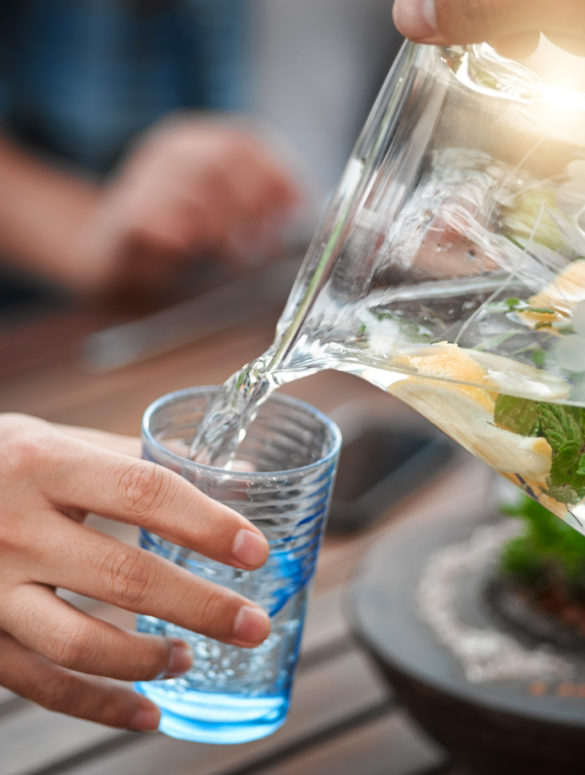Are You Drinking Toxins? Search the EWG City Water Database
One half of all Americans are unknowingly drinking toxins like lead, radon, radium 226, chloroform and asbestos. And this is no secret, as municipal water sources are making public knowledge of these tap water contaminants on the EWG website.
Some people have already caught on and have switched to a Brita filter or plastic bottled water. Unfortunately, independent studies show that the Brita filter does not remove a majority of the concerning toxins. And bottled water is not only bad for the environment, but is not regulated, so companies can put whatever they want into the bottle. The bottle itself contains contaminants that leach into the water like BPA and and some companies add drying agents to the water that actually make your mouth feel more dry, and therefore, still thirsty so that you will drink more of their product.
We’ve spent some time compiling information on all the most common sources of drinking water, to give you information and ideas on how to choose the best water for your health!
Is Tap Water Ruining Your Health?
Sorry to sound bleak, but this is quite serious.
Access to a treated water supply is apparently the single greatest determinant in public health. We have made global progress with creating reliable and “safe” water supplies, but “safe” means different things to different people.
Questionable Sources Of Tap Water:
City water, or tap water, comes from different sources including rivers, lakes, rainwater runoff, snowmelt, and aquifers. This water ends up sitting around for weeks and months in holding areas. These holding areas are not completely protected from rain water, sunlight, wildlife, outside air, environmental pollutants, bacteria, viruses and fungi, or the corrosion of the holding and transportation containers. These, among other variables, contribute to the contamination of municipal water.
Disinfecting Agents:
Tap water must be disinfected to make sure it is “safe” for human consumption. In order to produce this kind of “safe” water, carcinogenic disinfecting chemicals- including chlorine- are added to remove bacteria. When chlorine mixes with organic compounds in water, it forms chloroform, a cancer-causing carcinogen.
Environmental Toxins:
Tap water is also periodically tested for toxic chemicals including lead, asbestos, arsenic, formaldehyde, and aluminum. Unfortunately, not all toxic chemicals are required to be tested for, and when toxic chemicals are found in drinking water, nothing is done to remove them. See what’s in your drinking water by searching your zip code on this EWG site. An alarming number of pollutants exceed the health limits, and trihalomethanes actually EXCEED THE LEGAL LIMIT in Los Angeles, California.
Disturbing Truth About Tap Water:
Toxic chemicals often don’t cause immediate death or illness. They do cause delayed-onset chronic disease and cancer though (Remember Erin Brockovich and hexavalent chromium?) And guess what, even after Erin Brokovich, you can still find hexavalent chromium in cities across the U.S.
Here are two examples of toxic chemicals that are poisoning 50% of Americans through their water supply:
Lead
Lead has been detected in 39 states’ drinking water, and affects 101,369,947 people’s drinking supply (that’s approximately one third of the population of the U.S.A.) To learn more about how lead gets into drinking water look at this EWG article.
The U.S. Environmental Protection Agency (EPA) recommends a Maximum Contaminant Level Goal (MCLG) of zero for lead in drinking water.
Health Concerns for Lead include Spontaneous abortion, Developmental/reproductive toxicity, Cancer, Organ system toxicity (non-reproductive), Persistence and bioaccumulation, Allergies/immunotoxicity, Neurotoxicity, Occupational hazards, Endocrine disruption, Ecotoxicology, Enhanced skin absorption.” For more information about the health risks of lead, look at this article.
Chloroform
Chloroform has been detected in 41 states’ drinking water and affects 191,326,649 people’s drinking supply (that’s approximately one half the population of the U.S.A.).
“Chloroform is a carcinogenic pollutant that forms when disinfection agents such as chlorine and chloramine react with organic matter in drinking water sources and in wastewater treatment,” (Richardson 2007; International Agency for Research on Cancer (IARC) 2008b).
Health Concerns for Chloroform: “In humans chloroform is known to cause nausea, vomiting, irregular heartbeat, kidney damage, liver damage, dizziness, fatigue, drowsiness, insomnia, increased dreaming, impaired memory, and anorexia. In animals, chloroform is known to cause infertility, birth defects and cancer,” (ATSDR 1997b; Integrated Risk Information System (IRIS) 2001b).
Lead and Chloroform stats come from the EWG website These are only two toxins out of hundreds listed on the site.
Unfortunately, Bottled Water Is Not The Answer
You may be thinking that you are fine since you avoid tap water by buying your own bottled water. However, bottled water is not the solution. Here are three reasons why I avoid bottled water:
Environmental Harm:
Americans discard an average of 2.5 million bottles per hour. I know, that statistic sounds ridiculous. It is ridiculous, but it’s the current reality. Plastic bottles cause wildlife death, water pollution, wildlife hormone imbalance, energy consumption, etc. It’s time to stop purchasing products that come in plastic, including water. The only time I ever use plastic bottles anymore is if I am stuck in a situation where I need water for urgent medical reasons and I don’t have any other option. I will also use reclaimed plastic bottles from family and friends to collect spring water. I’ve given up all branded beverages that come in plastic bottles.
Contaminants:
Plastic chemicals leach from the bottle itself into the water. These plastic chemicals (BPA is only one of them) are estrogen-mimicking and are causing these problems in humans: breast and cervical cancer, prostate cancer, stubborn fat deposits, and “gender bender” effects like “man-boobs,” among many others.
In addition to the plastic contamination, there are other toxins in bottled water. “NRDC undertook a four-year, detailed investigation to evaluate the quality of bottled water…through three leading independent laboratories, we conducted “snapshot” testing of more than 1,000 bottles of water sold under 103 brand names.
What NRDC has found is in some cases reassuring and in others genuinely troubling…
The independent labs that conducted testing for NRDC found high levels of heterotrophic-plate-count bacteria in some samples, and in a few cases coliform bacteria… The labs also found that some samples contained arsenic (a carcinogen) and synthetic organic chemicals (SOCs, i.e., man-made chemicals containing hydrogen and carbon), such as those contained in gasoline or used in industry. SOCs found included the probable human carcinogen phthalate (likely from the plastic water bottles), and trihalomethanes (cancer-causing by-products of water chlorination, which have been associated with birth defects and spontaneous abortions when found in tap water at high levels).[3b]”
Here is the full report of the NRDC.
Cost:
Bottled water can get expensive after a while. If you are using the average amount of water for drinking and cooking, which is about 1 gallon per person per day, you are going to end up spending about $350 annually per person on bottled water at $1/gallon…and that’s a modest estimate. You could get a good-quality filter that would give you healthier water, and a few reusable water bottles for the same cost.
Is Filtered Water The Answer?
Some filters are a good alternative to tap and bottled water. There are a few popular ones that do not filter as well as they imply. Here are our reviews:
Reverse Osmosis:
Reverse Osmosis is a type of filtration process that removes all particle types from the water, leaving a water that is completely free from toxins. However, it also removes trace minerals, and our bodies are used to getting a significant amount of minerals from our water. So if you drink reverse osmosis water, make sure that it is not the only source of water you drink. Mix it up with some of the others below!
In addition, if you are eating a nutrient-dense diet, including several superfoods, and you are taking a trace mineral supplement you can be fine drinking reverse osmosis part of the time. Reverse Osmosis water is a great option when you are making something like bone broth, or tea, because those preparation add many mineral back into the water.
You can find reverse osmosis water in most health food stores and water stores for about $.30/gallon. Or, many people choose to install a reverse osmosis system into their homes.
Alkaline Water:
There are so many different kinds of alkaline water filters that it is difficult to make a generalized statement here. I will say that this kind of water filter system remains largely a mystery to me. As far as I can tell, an alkaline system utilizes a water filter and then adds trace minerals in to alkalize the water. The source, purity and overall safety of those trace minerals will always remain a concern for me. The efficacy of the water filter being used in each individual system is also a concern.
I have also been unable to notice any difference in the way I feel when I drink alkaline water exclusively for several weeks. Perhaps I was using a filter that was not the best quality. I have met people who say that it has done wonders. However, they were also making other lifestyle changes simultaneously.
Alkaline filters can also be very expensive.
Despite all of that, if it speaks to you, I would recommend the Zen Water Systems Alkaline Gravity Filter. It is actually affordable ($60-$90) and removes almost 100% of common toxic elements found in tap water. You can read the full efficacy report on this filter here.
Berkey Filter:
A Berkey Filter is the most effective gravity water filter on the market that I’ve been able to find. It removes 100% of lead, copper, arsenic, cadmium, uranium, mercury, and strontium. It is an investment of about $350, but again, that is what you would be spending on bottled water in one year if you went that route. You can read more about the Berkey filter lab results here. This is the model of Berkey filter that I recommend: Berkey Water Filter System w/ 2 Black and 2 Fluoride/Arsenic Filters.
Distilled:
This is something that old-school naturopaths seem to recommend to me a lot. I’ve never been a fan of it because of the intensive process used to create it, then the fact that it needs to be bottled in plastic (because distillation machines are not accessible to the average homeowner). Although it is free from toxins, I think there are better options available.
Brita Filter:
This filter is actually one of the worst performing household water filters on the market. According to one study, it actually increased aluminum content by 33%, while decreasing lead and arsenic content by only 14% and 12%, respectively. You can read the full report here. Brita is also expensive, especially for a product that underperforms. The Brita website recommends changing the filter after every 40 gallons. Again, someone living the Take Back Your Health™ Lifestyle and using filtered water for drinking and cooking should be using approx. 1 gallon/day. That means you should change your filter about once per month. With an average cost of $6-$11/filter, that’s $60-$110/year. For a family of 4, that’s $240-$440/year. I’d rather pay a little more for a more effective filter and reap the health benefits.
Yes, there are other filters on the market, however my goal with this post was not to review every water filter available. I only reviewed the most popular and recommended filters that I have come across in my studies.
How About Fresh Spring Water?
I think this is a great option for clean and affordable drinking water! In fact, the TBYH team dedicated an entire post to exploring the benefits of spring water, sharing where to find it, and addressing common concerns. You can find that post here.
Top 4 Healthiest Drinking Water Sources
Despite the toxic contaminants in most sources of drinking water, there are healthy options.
This is a long post with a lot of technical information, so for those of you who want to know right up front which sources of water I use and believe to be the healthiest, here you go:
- Fresh Spring Water gathered at the source and tested with 2 separate home water tests: Test 1 & Test 2. Don’t forget to also test for Radon. You can find reliable and well-used springs on www.FindASpring.com.
- Filtered Tap Water from a Berkey Filter with the fluoride/arsenic filter OR a Zen Water Systems Alkaline Filter. The Berkey filter takes all minerals out of the water, which can lead to other health issues, so only use this filter if your diet is extremely rich with trace minerals and you are supplementing.
- Well Water. Only after testing with 2 separate home water tests: Test 1 & Test 2. Don’t forget to also test for Radon. This water usually retains many natural trace minerals.
- Reverse Osmosis. This method of filtration takes all of the minerals out of the water, so proceed with caution. Only use this filter is you have a diet that is extremely rich in trace minerals and you are supplementing.
Did this article help you make an informed decision about the best water source for you and your family? Let me know!








